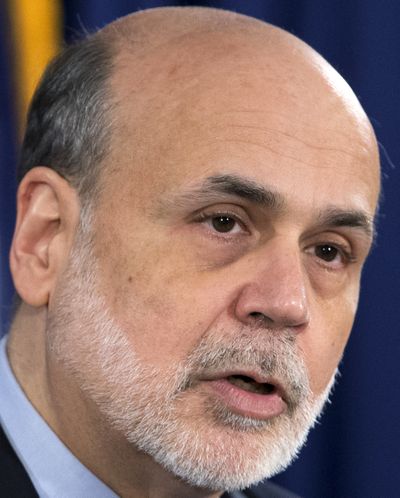Fed: Stay the course
Short-term interest rates to remain at record lows

WASHINGTON – The Federal Reserve isn’t yet convinced that the U.S. economy’s growth can accelerate without the Fed’s drive to keep borrowing costs at record lows. It wants to see sustained improvement.
That was the message Fed officials sent Wednesday, when they reinforced their plan to keep short-term interest rates at record lows at least until unemployment falls to 6.5 percent.
An unemployment rate of 6.5 percent is a threshold, not a “trigger,” for a possible rate increase, Chairman Ben Bernanke said at a news conference.
“We are seeing improvement,” he said. “One thing we would need is to see this is not temporary improvement.”
The Fed will continue buying $85 billion a month in bonds indefinitely to keep long-term borrowing costs down. Bernanke said the Fed might vary the size of its monthly purchases depending on whether or how much the job market improves. The unemployment rate has fallen to a four-year low of 7.7 percent, among many signs of a healthier economy.
Investors seemed pleased with the Fed’s decision to maintain its low-interest rate policies indefinitely for now.
The Fed’s statement took note of the global stresses that have been intensified by the turmoil in Cyprus, which is trying to stave off financial ruin. No longer does the Fed statement say, as it did in January, that “strains in global financial markets have eased somewhat.”
Bernanke was asked at his news conference whether the flare-up in Cyprus signals that the U.S. financial system might be more vulnerable than bank “stress tests” have shown. He sought to downplay the dangers posed by the tiny Mediterranean nation. Bernanke said that “at this point,” he sees no major risks to the U.S. financial system or economy.
The Fed noted in its statement that the U.S. job market has improved, consumer spending and business investment have increased and the housing market has strengthened. But its latest economic forecasts, also released Wednesday, show that the Fed still doesn’t expect unemployment to reach 6.5 percent until 2015.
The Fed also cautioned that government spending cuts and tax increases could slow the economy. It predicts that growth won’t exceed 2.8 percent this year, slightly lower than its December forecast of 3 percent.
A total of 13 Fed officials still think the first rate increase won’t occur until 2015, the same number that thought so in December. One Fed official thinks the first boost in the short-term lending rate won’t occur until 2016.
The statement was approved on an 11-1 vote. Esther George, president of the Kansas City regional Fed bank, dissented for a second straight meeting. She reiterated her concerns that the Fed’s aggressive stimulus could heighten the risk of inflation and financial instability – a concern shared by other critics.
Some economists say they fear the Fed has pumped so much money into the financial system that it could eventually ignite inflation, fuel speculative asset bubbles or destabilize markets once the Fed has to start raising rates or unloading its record $3 trillion investment portfolio.
And while the Fed’s low interest-rate policies are intended to boost borrowing, spending and stock prices, they also hurt millions of retirees and others who depend on income from savings.
“Things are not going to get better for savers,” said Greg McBride, senior financial analyst at Bankrate.com. “Rates are going to stay low for borrowers, and the Fed’s accommodation will continue to be a positive for the stock market. Right now, the market is addicted to Fed stimulus.”